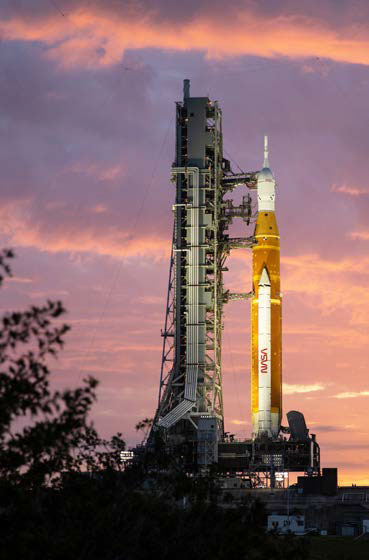Brice Wallace
By the time you read this, humankind’s next step in space exploration and travel could be underway with the launch of the Artemis 1 mission toward the moon.
And Utahns knowledgeable about space are hoping that it inspires a new generation of companies and individuals to get involved, the same way Mercury, Gemini and Apollo stirred Americans decades ago.
“Just even the uncrewed test flight on Artemis 1, let alone the crewed flight where they circumnavigate the moon in orbit and seeing those high-definition pictures and what that’s going to do for the industry throughout the United States but certainly here in Utah{mprestriction ids="1,3"}, [for] that next generation of aerospace workers, engineers, scientists, it’s just going to be incredible,” said Douglas Hurley, former NASA astronaut and senior director of strategy and business development at Northrop Grumman Corp.
Speaking at a discussion about aerospace and defense at the One Utah Summit, Hurley and others predicted a space renaissance, with the Artemis program sparking interest in the heavens.
Artemis 1 was scheduled to launch from Florida on August 29, carrying an unmanned Orion spacecraft to the moon. Later missions will be manned, with astronauts expected to orbit the moon in a craft dubbed Gateway, land on the moon, drive rovers on its surface and establish a base camp that could be a springboard for future missions to Mars.
“This is a really good time to be in space because there are lots of things, lots of opportunities, for folks in the aerospace world to contribute to that,” said Ned Penley, deputy associate administrator for management at NASA. “It’s amazing to look at that [Artemis] vehicle and think of all the companies — small companies, mid-sized companies — contributing to its creation.”
A look at the NASA Artemis website shows lots of Utahns already involved in the program, with map markers indicating companies from Smithfield in Cache County to Cedar City. One of the panelists said Utah has 27 supplier companies and 1,500 workers contributing.
Perhaps the most apparent components are the two solid-fuel rocket boosters that help launch Artemis. Based on the space shuttle boosters, the new Northrop Grumman boosters are the largest, most powerful solid-propellant boosters ever built for flight.
In addition to Artemis, Penley said companies also have other opportunities to get involved in commercial space endeavors. Those are in their early stages, much the same way that biplanes carrying mail to and from Salt Lake City eventually carried passengers, paving the way for the airline industry and giant hubs like Salt Lake City International Airport.
“Do you think that the folks that were flying their biplanes around, if you had asked them, ‘Hey, what’s the vision for this? Is there going to be like a giant, multi-hundreds-of-acres airport here?’ They probably couldn’t have envisioned that,” Penley said.
“But they would have known something cool was happening here: ‘We’re taking passengers and there’s a change. There’s a shift, and this is going to work. This is going to be really cool.’ And I think we’re there with the commercial space industry right now. You’re seeing it happen right now, and we’re just at that point, where this commercial space, something cool’s happening.”
Brock Alexander, vice president of government and defense for 5N Plus Inc., said that as more rocket launches are successful and more astronauts and satellites go into space, costs will shrink “and that opens up a lot of opportunity for small companies. … As the costs come down, there’s just going to be more exploration in space and more applications.”
5N is a global company with about 60 employees in St. George. They make semiconductor wafers that go into space, including the substrate for solar cells.
Another example of Utah company involvement is Intergalactic. The St. George-based aerospace company builds thermal management systems. It has been working on Artemis landers and rovers.
“It’s massive,” Brian McCann, president and CEO, said of the opportunities available to companies interested in space. “It’s the biggest emerging industry since the Internet.”
Penley said NASA is re-evaluating the way it does procurement, favoring private companies designing and owning systems, with NASA then purchasing their services.
“That actually opens up the innovation kind of thing because if companies are now responsible for the ownership and entrepreneurship of all of that, they can go out and find other customers,” he said. “So that’s pretty cool, and that incentivizes the system to broaden out.”
Projects like Artemis and Mars missions will require innovation “all the way, top to bottom,” that companies of all sizes will need to provide, he said.
“To me, this type of innovation and the companies that are out there figuring out new ways of doing stuff, we need, we desperately need,” he said. “We don’t go down to Ace Hardware and just buy this stuff and bolt it all together. It’s got to be innovative and we’ve got to come up with new ways of doing stuff.”
Panelists said Utah is positioned to do well in the space-focused future. McCann said the state has an educated workforce that loves to work and is young. “There’s a pipeline to keep that going,” he said.
But one obstacle has been “an intimidation factor” with aerospace, he said. But that can be overcome if young people understand that “some really cool stuff” has the ability to change the whole course of human history, he said.
“The things that have come out of NASA, we use them every day in our households. It’s a really, really cool industry,” McCann said.
With many established companies already involved in aerospace, Utah is “a real burgeoning place to develop space and defense experts,” Hurley said.
“The future,” he said, “in aerospace and defense for Utah is absolutely — it’s a cliché — but it’s just going to be great.”{/mprestriction}








